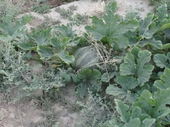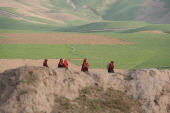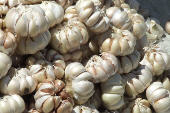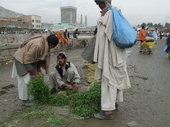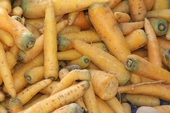

From Afghan people for Afghanistan

The Preservation of heritage seeds in Afghanistan

Rasaq Qadirie, MSc

Please email us for more information or support opportunities
Articles
| Afghani Melons, published in Seeds of Diversity, 2014 | |
| The Importance of Indigenuos Seeds in Afghanistan, published in Seeds of Diversity, 2012 |
Update: May 2011
Please click on the photos to read the corresponding text.
(click on a photo to enlarge)
Update: January 2011
I'm optimistic that as we work the soil year after year, it will become more fertile and we will learn more about our garden's conditions. We hope to reproduce a wider variety of local seeds in the future, for distribution.
(click on a photo to enlarge)
At District Andkhoy's education center, I gave a guest lecture to about 40 teachers, students, and some local farmers, who were very interested and happy to hear about the value and potential of their local seeds, fruit trees and herbs.
(click on a photo to enlarge)
Next year, we'll start growing local wheat, oats, sesame, and cumin, and various types of vegetables (such as cucumbers, tomatoes, spinach). We hope to increase our community involvement, and perhaps arrange some field trips to the garden for the education center's students.
(click on a photo to enlarge)
About
Afghanistan is naturally one of the most ecologically diverse countries in the world, with a vast variation of fruits, vegetables and herbs. Many of the ‘exotic’ fruits and vegetables you see in North America and Europe today have been imported from Afghanistan over the past 200 years—pomegranates, cherries, apricots, grapes, pears. However, this diversity is rapidly depleting. In 1928 there were over 100 strains of wheat. Today there are less than 30. In the Western province of Herat there were once over 100 types of grapes. Today it is difficult to find a dozen.
(click on a photo to enlarge)
Prior to 1978 and the civil war, Afghans were known for their good health and good teeth. The war destroyed the balance of economy, agriculture, infrastructure, and social services. Left in desolate conditions, Afghans have been betrayed by failing water management, education system, and the eradication of tradition, import/export practices, and a negative international stigma.
(click on a photo to enlarge)
A common misconception of Afghanistan is that it sustains itself on opium production. In actuality, you must consider who is buying the drugs and who is profiting from this. Are they Afghans? It is important to note that poppies require half the amount of water that grains need to grow. The lack of water is the main problem for agriculture and food production. Investment in water management and an adequate water supply would allow Afghan farmers to produce enough for a livelihood.
(click on a photo to enlarge)
Another issue that must be addressed is the re-introduction of the traditional growing technique lalmi and the use of heritage seeds. The heritage seeds in Afghanistan—those that have been used for thousands of years—have a naturally built up resistance to disease and have adjusted to the climate and soil, thus making them vital to farmers and the environment. Many strains of heritage wheat are grown on the Afghan hillsides using lalmi. The growth requires only rainwater and pesticides have never been used. The fruits of these traditional seeds and methods—wheat, tomatoes, carrots—are a rich and wonderful product.
(click on a photo to enlarge)
While Afghanistan is an agricultural country, it imports over 90% of its seeds, mainly from Pakistan, China, and Turkmenistan. These seeds are produced on large farms and grown with the aid of genetic modification and pesticides. Not only are traditions and seed diversity being eradicated, but many Afghans are finding themselves with new allergies as a result of the chemically induced practices. Afghans are frequently unsatisfied with the taste and flavour of that which is grown from imported seeds relative to heritage seeds. Sadly, some farmers believe that foreign seeds will become indigenous once planted in Afghan soil, causing their increased use.


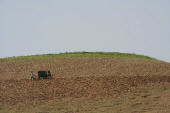
(click on a photo to enlarge)
Finally, in my experience, I have found that the damage done to agriculture and education are both correlated and extremely detrimental. With millions of educated Afghans leaving since the onset of the war, and the destruction of the education system, illiteracy has become a major issue, even in regards to food production. Traditionally knowledge has been passed down orally through the generations, but today without written record, it is being lost. Although farmers have outstanding knowledge of technique, soil and climate, the majority are illiterate. The need for a democratically elected government is vital for the much needed improvement of the education system.
(click on a photo to enlarge)
I would like to thank all of my friends who have supported me in this endeavor, by inspiring me, organizing a slide show, writing text, giving me seed books and fundraising, especially John Steven, Lisa Kadonaga, Susie Osler and Colleen Sullivan. My friend Stefan and I were able to travel to Afghanistan in May 2006 to help and research in ten provinces (Kabul, Parwan, Baghlan, Samagan, Kanduz, Takhar, Badakhshan, Balkh, Jowzjan and Faryab). Although the journey was often difficult—the roads were so bad it once took ten hours to travel 100km—we were able to do a lot of good. We collected indigenous seeds for 40 kinds of vegetables, 25 kinds of herbs and 15 kinds of grains. We commenced the building of a seed barn in Kabul. And we were able to talk with many farmers about the importance of indigenous seeds and techniques, as well as emphasize the notion of quality over quantity.
(click on a photo to enlarge)
Currently in Afghanistan there are more than 40 000 international soldiers. Imagine that each of these soldiers invested only 1% of their accommodation budget spent in the last five years on agriculture. Or imagine that each soldier planted two plants or trees. That would be true reconstruction. I am originally from Afghanistan and have traveled there many times since 1990. I have seen the quality of food and health deteriorate. After 25 years of war, poverty, starvation, inflation and depression many can no longer fathom a better future. In the West we frequently hear about the reconstruction of Afghanistan, but this action is hard to see. What needs to take priority is the perpetuation of the positive value of the Afghan language, culture, agricultural practices, seeds and natural medicines. I see a lot of potential in the Afghan people. However, there needs to be a democratically elected government who understands Afghanistan—who we were, who we are, what we had, what we have and most importantly, where we will be in the future and the steps it will take to get us there.
Thank you for contacting the Afghan Community Seed Bank Project. Our
project leader is working in Afghanistan, so we regret that there will be
a delay in responding to e-mails. In the meantime, Lisa Kadonaga (in
Victoria, B.C.) will be acting as Canadian co-ordinator. We hope to send
you an individual response to your messages, regarding donations or other
questions. We have placed your name on our bulletin list, and will be
issuing seasonal updates on the project
--
please let us know if you would
like us to send them to a different e-mail address, or if you would prefer that we not send you further information. (We will not be sharing our
bulletin list with any other organizations.)
Again, many thanks for your interest.
Rasaq Qadirie
Lisa Kadonaga
Would you like to support our project?
Please send us an email for more information
 zur deutschen Version
zur deutschen Version







